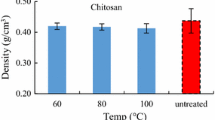Abstract
The uptake of chitosan based impregnation solutions were tested on Scots pine (Pinus sylvestris L), Beech (Fagus sylvatica L.), Downy birch (Betula pubescens Ehrh.) and Norway spruce (Picea abies L. Karst.) in longitudinal, radial and tangential directions separately. The four chitosans tested had a fraction of acetylated residues (FA) of 0.198 and average molecular weights ranging from 18 to 129 kDalton. The kinetic viscosity of the 2.4% (weight/volume) solutions at pH 5.0 was in the range of 2.95 to 28.8 mm2 s-1. The general trend showed that there was an increase in uptake of chitosan based impregnation solutions with decreasing viscosity, and the chitosan solution with the lowest viscosity had almost comparable uptake with water for Pine and Beech in the longitudinal direction. In general, the lower the ability for uptake of impregnation solution, the more the viscosity influences the uptake.
Zusammenfassung
An Kiefer (Pinus sylvestris L.), Buche (Fagus sylvatica L.), Flaumbirke (Betula pubescens Ehrh.) und Fichte (Picea abies L. Karst.) wurde die Aufnahme chitosanbasierter Imprägnierlösungen getrennt in longitudinaler, radialer und tangentialer Richtung untersucht. Die vier untersuchten Chitosane besassen Anteile an acetylierten Resten (FA) von 0.198 und durchschnittliche Molmassen von 18 bis 129 kDalton. Die kinetische Viskosität der Lösungen 2.4% (Masse/Volumen) bei pH 5.0 lag zwischen 2.95 und 28.8 mm2 s-1. Generell zeigte sich, dass mit abnehmender Viskosität die Aufnahme chitosanbasierter Imprägnierlösungen zunahm, und die Chitosanlösung mit der geringsten Viskosität bei Kiefer und Buche in longitudinaler Richtung fast mit Wasser vergleichbare Aufnahmen erzielt. Im Allgemeinen gilt, dass je geringer die Fähigkeit zur Aufnahme von Imprägnierlösungen ist, desto stärker beeinflusst die Viskosität die Aufnahme.
Similar content being viewed by others
References
Alfredsen G, Eikenes M, Solheim H, Militz H (2004) Screening of chitosan against wood deteriorating fungi. Scand J Forest Res 19(5):4–13
Allan C, Hadwiger L (1979) The fungicidal effect of chitosan on fungi of varying cell wall composition. Exp Mycol 2:285–287
Allan G, Peyron M (1995) Molecular weight manipulation of chitosan I: kinetics of depolymerization by nitrous acid. Carbohyd Res 277:257–272
Chittenden C, Kreber B, McDowell N, Singh T (2004) In vitro studies on the effect of chitosan on mycelium and spore germination of decay fungi, moulds and staining fungi. In: 35th Annual meeting in The International Research Group on Wood Preservation, Ljubljana. IRG/WP 04-10507
Chittenden C, Wakeling R, Kreber B (2003) Growth of two selected sapstain fungi and one mould on chitosan amended nutrient medium. In: 34th Annual meeting in The International Research Group of Wood Preservation, Brisbane. IRG/WP 03-10466
Eikenes M, Alfredsen G, Christensen B, Militz H, Solheim H (2004) Comparison of chitosan with different molecular weights as possible wood preservative. J Wood Sci 51(4):387–394
Frederiksen O (2001) Fungicid fra rejer (in Danish). Teknologisk Institut, Bioteknik
Frey-Wyssling A (1937) Über die submikroskopische Morphologie der Zellwände (in German). Deut Bot Gesell 55:119–133
Kobayashi T, Furukawa I (1995a) Optimum conditions for the formation of chitosan-metal salts and their fixation in wood (in Japanese). J Antibact Antifung Agents 23:263–269
Kobayashi T, Furukawa I (1995b) Wood-preserving effectiveness of chitosan-metal salts against wood decaying fungi (in Japanese). J Antibact Antifung Agents 23:343–348
Kumar M (2000) A review of chitin and chitosan applications. React Funct Polym 46:1–27
Laflamme P, Benhamou N, Bussires G, Dessureault M (1999) Differential effect of chitosan on root rot fungal pathogens in forest nurseries. Can J Bot 77:1460–1468
Lee J-S, Furukawa I, Sakuno T (1992) Microdistribution of elements in wood after pre-treatment with chitosan and impregnation with chrome-copper-arsenic preservative (in Japanese). Mokuzai Gakkaishi 38:186–192
Lee J-S, Furukawa I, Sakuno T (1993) Preservative effectiveness against Tyromyces palustris in wood after pre-treatment with chitosan and impregnation with chromated copper arsenate (in Japanese). Mokuzai Gakkaishi 39:103–108
Liese W (1951) Über die Bedeutung der Holzstruktur für das Eindringung öliger Holzschutzmittel (in German). Dissertation, Forstliche Fakultät, University of Göttingen
Liese W, Bauch J (1967) On anatomical causes of the refractory behavior of Spruce and Douglas fir. J I Wood Sci 19:3–14
Maoz M, Morrell J (2004) Ability of chitosans to limit wood decay under laboratory conditions. In: 35th Annual meeting in The International Research Group on Wood Preservation, Ljubljana. IRG/WP 04-30339
Mehrtens S (1999) Untersuchungen zur Schutzwirkung von Chitosan gegenüber Holzpilzen (in German). Diploma thesis, Fachbereich Biologie, University of Hamburg
Militz H (1990) Die Verbesserung der Imprägnierbarkeit von Fichtenholz mittels chemischer und enzymatischer Vorbehandlung (in German). PhD Thesis, University of Wageningen
Mima S, Miya M, Iwamoto R, Yoshikawa S (1983) Highly deacetylated chitosan and its properties. J Appl Polym Sci 28:1909–1917
Müller J (1996) Mittel zum Behandeln von Holz (in German). Deutsches Patentamt DE19636702A1
Nicholas D (1973) Wood deterioration and its prevention by preservative treatments: Preservatives and preservative systems. In: Cote A (ed) Syracuse Wood Science Series. Syracuse University Press
Rapp A (1993) Entwicklung einer Prüfmethode zur Tränkbarkeit von Holz (in German). Diploma thesis, University of Hamburg
Ratajska M, Struszczyk M, Boryniec S, Peter M, Loth F (1997) The degree of deacetylation of chitosan: optimization of the IR method. Polimery 42:572–575
Sandford P (2002) Commercial sources of chitin & chitosan and their utilization. In: Vårum K, Domard A, Smidsrød O (eds) 5th International Conference of the European Chitin Society. The European Chitin Society, Trondheim, pp 35–42
Schmidt O, Müller J, Moreth U (1995) Potentielle Schutzwirkung von Chitosan gegen Holzpilze (in German). Holzzentralblatt 121:2503
Stemsrud K (1989) Trevirkets oppbygning – Vedanatomi (in Norwegian). Universitetsforlaget, Oslo
Trendelenburg R (1939) Das Holz als Rohstoff (in German). J.F. Lehmans Verlag, München
Vårum K, Ottøy M, Smidsrød O (1994) Water-solubility of partially N-acetylatedchitosans as a function of pH: effect of chemical composition and depolymerisation. Carbohyd Polym 25:65–70
Author information
Authors and Affiliations
Corresponding author
Rights and permissions
About this article
Cite this article
Larnøy, E., Militz, H. & Eikenes, M. Uptake of chitosan based impregnation solutions with varying viscosities in four different European wood species. Holz Roh Werkst 63, 456–462 (2005). https://doi.org/10.1007/s00107-005-0014-7
Published:
Issue Date:
DOI: https://doi.org/10.1007/s00107-005-0014-7




